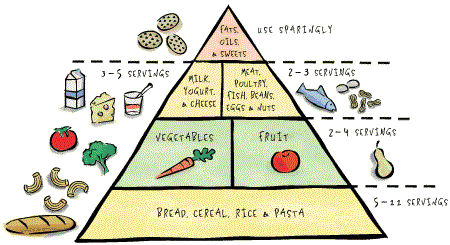USDA Food Guide Pyramid

In general, the
guidelines advocate eating plenty of breads, cereals, rice, pasta, vegetables and fruits,
as well as two to three servings from the milk group and two to three servings from the
meat group. Go easy on fats, oils and sweets, the foods in the small tip of the pyramid.
The USDA
pyramid is based on recommended "servings." Serving sizes are listed below. No
specific sizes are listed for fats, oils and sweets because those foods are to be used
sparingly.
| One serving of milk, yogurt or cheese equals a
cup of milk or yogurt, 1½ ounces of natural cheese or 2 ounces of processed cheese. | |
| A serving of meat, poultry, fish, dry beans,
eggs or nuts equals 2 to 3 ounces of cooked, lean meat, poultry or fish; ½ cup of cooked
dry beans; an egg; or 2 tablespoons of peanut butter. | |
| A serving of vegetables is a cup of raw, leafy
vegetables; ½ cup of other vegetables, cooked or raw; or ½ cup of vegetable juice. | |
| A serving of fruit is a medium apple, banana or
orange; ½ cup of chopped, cooked or canned fruit; or ½ cup of fruit juice. | |
| A serving of bread, cereal, rice or pasta consists of a slice of bread, 1 ounce of ready-to-eat cereal; or ½ cup of cooked cereal, rice or pasta. |
The USDA Food
Guide Pyramid is based on the 1995 dietary guidelines for Americans. It's not a rigid
prescription but a general guide meant to help people choose a diet that's right for them.
Source: United States Department of Agriculture